List of regions of the United States
Overview of U.S. regions From Wikipedia, the free encyclopedia
This is a list of some of the ways regions are defined in the United States. Many regions are defined in law or regulations by the federal government; others by shared culture and history, and others by economic factors.
Interstate regions
Summarize
Perspective
Census Bureau-designated regions and divisions

Since 1950, the United States Census Bureau defines four statistical regions, with nine divisions.[1][2] The Census Bureau region definition is "widely used... for data collection and analysis",[3] and is the most commonly used classification system.[4][5][6][7]
Puerto Rico and other US territories are not part of any census region or census division.[8]
Federal Reserve Banks
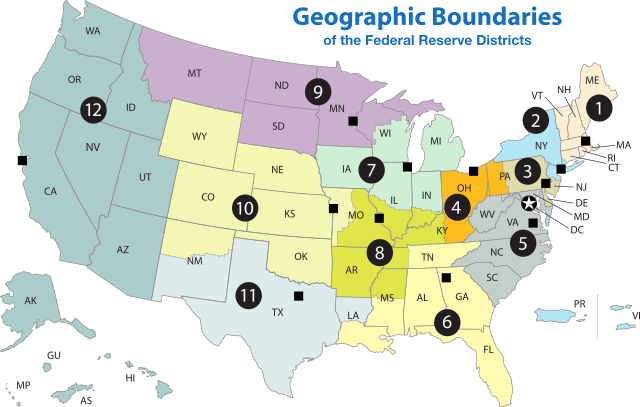
The Federal Reserve Act of 1913 divided the country into twelve districts with a central Federal Reserve Bank in each district. These twelve Federal Reserve Banks together form a major part of the Federal Reserve System, the central banking system of the United States. Missouri is the only U.S. state to have two Federal Reserve locations within its borders, but several other states are also divided between more than one district.
Time zones

- UTC−12:00 (Baker Island, Howland Island)
- Samoa Time Zone (American Samoa, Jarvis Island, Kingman Reef, Midway Atoll, Palmyra Atoll)
- Hawaii–Aleutian Time Zone (Hawaii, Aleutian Islands (Alaska), Johnston Atoll)
- Alaska Time Zone (Alaska, excluding Aleutian Islands)
- Pacific Time Zone
- Arizona Time Zone (excluding the Navajo Nation)[9]
- Mountain Time Zone (excluding most parts of Arizona)
- Central Time Zone
- Eastern Time Zone
- Atlantic Time Zone (Puerto Rico, U.S. Virgin Islands)
- Chamorro Time Zone (Guam, Northern Mariana Islands)
- Wake Island Time Zone (Wake Island)
Courts of Appeals circuits

- First Circuit
- Second Circuit
- Third Circuit
- Fourth Circuit
- Fifth Circuit
- Sixth Circuit
- Seventh Circuit
- Eighth Circuit
- Ninth Circuit
- Tenth Circuit
- Eleventh Circuit
- D.C. Circuit
The Federal Circuit is not a regional circuit. Its jurisdiction is nationwide but based on the subject matter.
Agency administrative regions
In 1969, the Office of Management and Budget published a list of ten "Standard Federal Regions",[10] to which federal agencies could be restructured as a means of standardizing government administration nationwide. Despite a finding in 1977 that this restructuring did not reduce administrative costs as initially expected,[11] and the complete rescinding of the standard region system in 1995,[12] several agencies continue to follow the system, including the Environmental Protection Agency[13] and the Department of Housing and Urban Development.[14]
Regions and office locations

Region I
Office location: Boston
States: Connecticut, Maine, Massachusetts, New Hampshire, Rhode Island, and Vermont
Region II
Office location: New York City
States: New York, New Jersey, Puerto Rico, and the U.S. Virgin Islands
Region III
Office location: Philadelphia
States: Delaware, Maryland, Pennsylvania, Virginia, Washington, D.C., and West Virginia
Region IV
Office location: Atlanta
States: Alabama, Florida, Georgia, Kentucky, Mississippi, North Carolina, South Carolina, and Tennessee
Region V
Office location: Chicago
States: Illinois, Indiana, Minnesota, Michigan, Ohio, and Wisconsin
Region VI
Office location: Dallas
States: Arkansas, Louisiana, New Mexico, Oklahoma, and Texas
Region VII
Office location: Kansas City
Region VIII
Office location: Denver
States: Colorado, Montana, North Dakota, South Dakota, Utah, and Wyoming
Region IX
Office location: San Francisco
States: Arizona, California, Hawaii, Nevada, Guam, Northern Mariana Islands, and American Samoa
Region X
Office location: Seattle
States: Alaska, Idaho, Oregon, and Washington
Bureau of Economic Analysis regions

The Bureau of Economic Analysis defines regions for comparison of economic data.[15]
- New England: Connecticut, Maine, Massachusetts, New Hampshire, Rhode Island, and Vermont
- Mideast: Delaware, Maryland, New Jersey, New York, Pennsylvania, and Washington, D.C.
- Great Lakes: Illinois, Indiana, Michigan, Ohio, and Wisconsin
- Plains: Iowa, Kansas, Minnesota, Missouri, Nebraska, North Dakota, and South Dakota
- Southeast: Alabama, Arkansas, Florida, Georgia, Kentucky, Louisiana, Mississippi, North Carolina, South Carolina, Tennessee, Virginia, and West Virginia
- Southwest: Arizona, New Mexico, Oklahoma, and Texas
- Rocky Mountain: Colorado, Idaho, Montana, Utah, and Wyoming
- Far West: Alaska, California, Hawaii, Nevada, Oregon, and Washington
Unofficial regions
Multi-state regions
- American Frontier
- Appalachia
- Ark-La-Tex
- Auto Alley
- Backcountry
- Black Dirt Region
- Border states:
- The Californias
- Calumet Region
- The Carolinas
- Cascadia[citation needed]
- Central United States
- Coastal states
- Colorado Plateau
- Columbia Basin
- Contiguous United States
- The Dakotas
- Deep South
- Deseret
- Delmarva Peninsula
- Dixie
- Dixie Alley
- Driftless Area
- East Coast
- Eastern United States
- Flyover country
- Four Corners
- Great American Desert
- Great Appalachian Valley
- Great Basin
- Great Lakes Region
- Great Plains
- Gulf Coast
- Heartland
- High Plains
- Interior Plains
- Intermountain States
- Kentuckiana
- Llano Estacado
- Lower 48
- Michiana
- Mid-Atlantic states
- Middle America
- Mid-South states
- Midwestern United States
- Mississippi Delta
- Mojave Desert
- Mormon Corridor
- New England
- Nickajack
- North Woods
- Northeastern United States
- Northern United States
- Northwestern United States
- Ohio Valley
- Old South
- Old Southwest
- Ozarks
- Pacific Northwest
- Palouse
- Piedmont
- Piney Woods
- Rocky Mountains
- Siouxland
- Southeastern United States
- Southern United States
- Southwestern United States
- Tidewater
- Tornado Alley
- Trans-Appalachia
- Trans-Mississippi
- Twin Tiers
- Upland South
- Upper Midwest
- Virginias
- Waxhaws
- West Coast
- Western United States
Multi-territory regions
- Mariana Islands (Guam and the Northern Mariana Islands)
- Samoan Islands (American Samoa, except Swains Island)[note 1]
- Virgin Islands (the Spanish Virgin Islands and the U.S. Virgin Islands)[note 2]
The Belts
Interstate megalopolises
Interstate metropolitan areas
- Central Savannah River Area (part of Georgia and South Carolina)
- Baltimore–Washington metropolitan area (Washington, D.C. and parts of Maryland, Virginia, West Virginia, and Pennsylvania)
- Washington metropolitan area (District of Columbia and parts of Maryland, Virginia, and West Virginia)
- Greater Boston (parts of Massachusetts, Rhode Island, and New Hampshire)
- Charlotte metropolitan area (parts of North Carolina and South Carolina)
- Chattanooga Metropolitan Area
- Chicago metropolitan area (parts of Illinois, Indiana, and Wisconsin)
- Cincinnati metropolitan area (parts of Ohio, Indiana, and Kentucky)
- Columbus-Auburn-Opelika (GA-AL) Combined Statistical Area (parts of Georgia and Alabama)
- Delaware Valley (parts of Pennsylvania, New Jersey, Delaware, and Maryland)
- Evansville, IN–KY Metropolitan Statistical Area (parts of Indiana and Kentucky)
- Fargo–Moorhead (parts of North Dakota and Minnesota)
- Fort Smith metropolitan area (parts of Arkansas and Oklahoma)
- Front Range Urban Corridor (parts of Colorado and Wyoming)
- Greater Grand Forks (part of Minnesota and North Dakota)
- Hartford-Springfield (parts of Connecticut and Massachusetts)
- Kansas City metropolitan area (parts of Missouri and Kansas)
- Louisville metropolitan area (Kentuckiana) (parts of Kentucky and Indiana)
- Memphis metropolitan area (parts of Tennessee, Arkansas, and Mississippi)
- Michiana (parts of Michigan and Indiana)
- Minneapolis–Saint Paul (the Twin Cities) (parts of Minnesota and Wisconsin)
- New York metropolitan area (parts of New York, New Jersey, Connecticut, and Pennsylvania)
- Omaha–Council Bluffs metropolitan area (parts of Nebraska and Iowa)
- Portland metropolitan area (parts of Oregon and Washington)
- Quad Cities (parts of Iowa and Illinois)
- Sacramento metropolitan area (parts of California and Nevada)
- Greater St. Louis (parts of Missouri and Illinois)
- Texarkana metropolitan area (parts of Texas and Arkansas)
- Tri-Cities (parts of Tennessee and Virginia)
- Twin Ports (Duluth, Minnesota and Superior, Wisconsin)
- Hampton Roads region (parts of Virginia and North Carolina)
- Youngstown–Warren–Boardman metropolitan statistical area (parts of Ohio and Pennsylvania)
Intrastate and intraterritory regions
Summarize
Perspective
Alabama

Regions of Alabama include:
Alaska

Regions of Alaska include:
American Samoa

Regions of American Samoa include:
Arizona

Regions of Arizona include:
Arkansas

Regions of Arkansas include:
California
Colorado

Regions of Colorado include:
- Central Colorado (part of Southern Rocky Mountains)
- Colorado Eastern Plains (part of High Plains)
- Colorado Mineral Belt (part of Southern Rocky Mountains)
- Colorado Piedmont (parts of the Front Range Urban Corridor and Colorado High Plains)
- Colorado Plateau (multi-state region)
- Colorado Western Slope (parts of Southern Rocky Mountains and Colorado Plateau)
- Denver Metropolitan Area (part of Front Range Urban Corridor)
- Four Corners Region (multi-state region of Colorado Plateau)
- Front Range Urban Corridor (multi-state region)
- High Plains (multi-state region of Great Plains)
- Mesa Verde
- North Central Colorado Urban Area (part of Front Range Urban Corridor)
- Northwestern Colorado (part of Southern Rocky Mountains)
- San Luis Valley
- South-Central Colorado
- South Central Colorado Urban Area (part of Front Range Urban Corridor)
- Southern Rocky Mountains (multi-state region of Rocky Mountains)
- Southwestern Colorado (parts of Southern Rocky Mountains and Colorado Plateau)
Connecticut

Connecticut has nine official planning regions, which operate as councils of governments and are recognized as county equivalents by the U.S. Census Bureau. The nine regions are:
- Capitol Region
- Greater Bridgeport
- Lower Connecticut River Valley
- Naugatuck Valley
- Northeastern Connecticut
- Northwest Hills
- South Central Connecticut
- Southeastern Connecticut
- Western Connecticut
Some of Connecticut's informal regions include:
Delaware

Regions of Delaware include:
- "Upstate" or "Up North":
- Delaware Valley, also known as "Above the Canal" (referring to the Chesapeake and Delaware Canal)
"Slower Lower":
- Cape Region
- Central Kent
- Delaware coast
District of Columbia
Florida

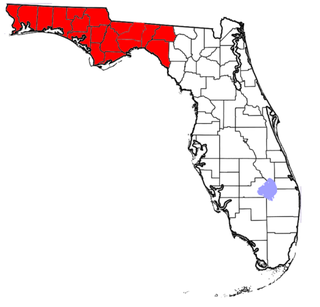
Directional regions of Florida include:
- Central Florida
- East Florida
- North Central Florida
- North Florida
- Northwest Florida
- Northeast Florida
- South Florida
- Southwest Florida
- West Florida
Local vernacular regions of Florida include:
Georgia
Regions of Georgia include:
- Atlanta metropolitan area
- Central Georgia
- Central Savannah River Area
- Colonial Coast
- Gold Belt
- Golden Isles of Georgia
- North Georgia
- North Georgia mountains (Northeast Georgia)
- Southern Rivers
- Southeast Georgia
- Wiregrass Region
Physiographic regions
Physiographic regions of Georgia include:
Guam
Regions of Guam include:
Hawaii


Regions of Hawaii include:
Idaho

Regions of Idaho include:
Illinois
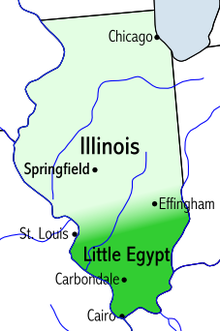
Regions of Illinois include:
- Central Illinois
- Champaign–Urbana metropolitan area
- Chicago metropolitan area
- Driftless Area
- Forgottonia
- Metro-East
- Metro Lakeland
- Military Tract of 1812
- Northern Illinois
- Northwestern Illinois
- Peoria, Illinois metropolitan area
- Quad Cities
- Rock River Valley
- Shawnee Hills
- Southern Illinois (sometimes, Little Egypt)
- Tri-State Area
- Wabash Valley
Indiana

Regions of Indiana include:
Iowa

Regions of Iowa include:
Kansas
Regions of Kansas include:
Kentucky
Regions of Kentucky include:
Louisiana

Regions of Louisiana include:
- Central Louisiana (Cen-La)
- Florida Parishes
- "French Louisiana" (Acadiana and Greater New Orleans)
- Greater New Orleans
- North Louisiana
- Southwest Louisiana
Maine
Regions of Maine include:
Maryland
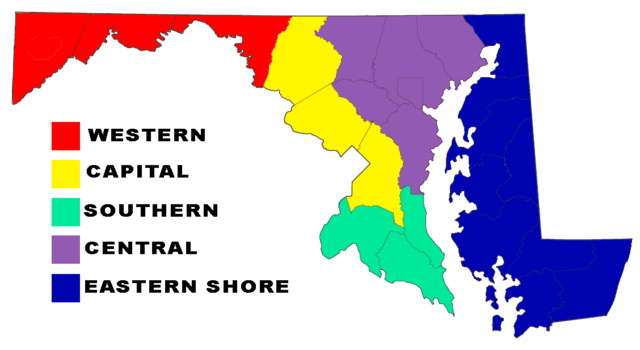
Regions of Maryland include:
- Baltimore–Washington Metropolitan Area
- Capital region
- Chesapeake Bay
- Eastern Shore of Maryland
- Patapsco Valley
- Southern Maryland
- Western Maryland
Regions of Maryland shared with other states include:
- Allegheny Mountains
- Atlantic coastal plain
- Blue Ridge Mountains
- Cumberland Valley
- Delaware Valley
- Delmarva Peninsula consists of Maryland's and Virginia's Eastern Shore and all of Delaware
- Piedmont (United States)
- Ridge-and-Valley Appalachians
Massachusetts

Regions of Massachusetts include:
- Central Massachusetts
- Northeastern Massachusetts
- Southeastern Massachusetts
- Western Massachusetts
- The Berkshires (shown in map)
- Housatonic Valley
- Pioneer Valley
- Quabbin-Swift River Valley
Michigan

Regions of Michigan include:
Lower Peninsula
Upper Peninsula
Minnesota

Regions of Minnesota include:
Mississippi
Regions of Mississippi include:
Missouri

Regions of Missouri include:
Montana
Regions of Montana include:
Nebraska

Regions of Nebraska include:
Nevada
Regions of Nevada include:
New Hampshire
Regions of New Hampshire include:
- Connecticut River Valley
- Dartmouth-Lake Sunapee Region (overlaps with Connecticut River Valley)
- Great North Woods Region
- Lakes Region
- Merrimack Valley
- Monadnock Region (overlaps with Connecticut River Valley)
- Seacoast Region
- White Mountains
New Jersey
Regions of New Jersey include:
New Mexico
Regions of New Mexico include:
New York
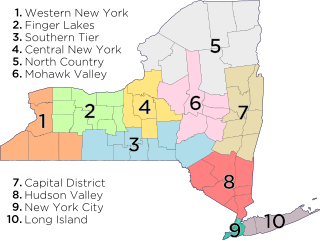
The ten regions of New York, as defined by the Empire State Development Corporation:
- Capital District – counties : Albany, Columbia, Greene, Warren, Washington, Saratoga, Schenectady, Rensselaer
- Central New York – counties: Cortland, Cayuga, Onondaga, Oswego, Madison
- Finger Lakes – counties: Orleans, Genesee, Wyoming, Monroe, Livingston, Wayne, Ontario, Yates, Seneca
- Hudson Valley – counties: Sullivan, Ulster, Dutchess, Orange, Putnam, Rockland, Westchester
- Long Island – counties: Nassau, Suffolk
- Mohawk Valley – counties: Oneida, Herkimer, Fulton, Montgomery, Otsego, Schoharie
- New York City – counties (boroughs): New York (Manhattan), Bronx (The Bronx), Queens (Queens), Kings (Brooklyn), Richmond (Staten Island)
- North Country – counties : St. Lawrence, Lewis, Jefferson, Hamilton, Essex, Clinton, Franklin
- Southern Tier – counties: Steuben, Schuyler, Chemung, Tompkins, Tioga, Chenango, Broome, Delaware
- Western New York – counties: Niagara, Erie, Chautauqua, Cattaraugus, Allegany
Regions of New York state include:
- Downstate New York
- Upstate New York
North Carolina

Regions of North Carolina include:
North Dakota
Regions of North Dakota include:
- Badlands
- Drift Prairie
- Missouri Escarpment
- Missouri Plateau (Missouri Coteau in French)
- Red River Valley
Northern Mariana Islands

Regions of the Northern Mariana Islands include:
Ohio

Regions of Ohio include:
- Allegheny Plateau
- Appalachian Ohio
- Cincinnati-Northern Kentucky metropolitan area
- Columbus, Ohio metropolitan area
- Connecticut Western Reserve (historic)
- Firelands
- Great Black Swamp (shared with Indiana)
- Knobs
- Lake Erie Islands
- Miami Valley
- Northeast Ohio (often used interchangeably with Greater Cleveland, but also includes the counties of Ashtabula, Portage, Summit, Trumbull, Mahoning and Columbiana.)
- Northwest Ohio
- Pennyroyal
Oklahoma

Regions of Oklahoma include:
Oregon


Regions of Oregon include:
- Cascade Range
- Central Oregon
- Columbia Plateau
- Columbia River
- Columbia River Gorge
- Eastern Oregon
- Goose Lake Valley
- Harney Basin
- High Desert
- Hood River Valley
- Mount Hood Corridor
- Northwest Oregon
- Oregon Coast
- Palouse
- Portland metropolitan area
- Rogue Valley
- Southern Oregon
- Treasure Valley
- Tualatin Valley
- Warner Valley
- Western Oregon
- Willamette Valley
Pennsylvania
Regions of Pennsylvania include:
- Allegheny National Forest
- Coal Region
- Cumberland Valley
- Delaware Valley
- Dutch Country
- Endless Mountains
- Highlands Region
- Laurel Highlands
- Lehigh Valley
- Lenapehoking
- Northern Tier
- Northeastern Pennsylvania
- Philadelphia Main Line
- Pittsburgh metropolitan area
- Slate Belt
- South Central Pennsylvania
- Susquehanna Valley
- The Poconos
- Western Pennsylvania
- Wyoming Valley
Puerto Rico

Regions of Puerto Rico include:
Rhode Island
Regions of Rhode Island include:
South Carolina
Regions of South Carolina include:
- The Lowcountry
- The Midlands
- The Upstate
- Travel/Tourism locations
- Other geographical distinctions:
South Dakota
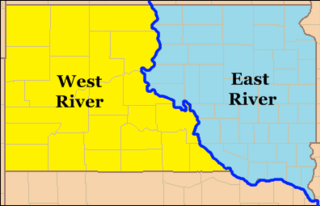
Regions of South Dakota include:
- Badlands
- Black Hills
- Coteau des Prairies
- East River and West River, divided by the Missouri River
Tennessee
The Grand Divisions of Tennessee include:
- East Tennessee
- Middle Tennessee
- West Tennessee
- Other geographical distinctions:
Texas

Regions of Texas include:
- Apacheria
- Brazos Valley
- Central Texas
- Comancheria
- Gulf Coast
- East Texas
- North Texas
- South Texas
- Southeast Texas
- Texas Midwest/West-Central Texas (includes Abilene, San Angelo, Brownwood, Texas)
- Texas Urban Triangle (Houston to San Antonio to Dallas-Fort Worth)
- West Texas
- Concho Valley
- Edwards Plateau
- Llano Estacado (a portion of northwest Texas)
- Permian Basin
- South Plains (includes 24 counties south of the Texas Panhandle and north of the Permian Basin)
- Texas Panhandle (pictured)
- Trans-Pecos
- Great Plains
U.S. Minor Outlying Islands

Regions of United States Minor Outlying Islands include:
U.S. Virgin Islands
Regions of United States Virgin Islands include:
Utah
Regions of Utah include:
Vermont
Regions of Vermont include:
Virginia

Regions of Virginia include:
Washington
Regions of Washington include:
West Virginia
Regions of West Virginia include:
Wisconsin

Wisconsin is divided into five geographic regions:
Wyoming
Regions of Wyoming include:
See also
- Geography of the United States
- Historic regions of the United States
- List of metropolitan areas of the United States
- Media market, e.g., Nielsen Designated Market Area
- Political divisions of the United States
- Regional stock exchanges of the United States
- United States territory
- Vernacular geography
- U.S. Caribbean region
Explanatory notes
- This region also includes the Independent State of Samoa, which is not a part of the United States
- This region also includes the British Virgin Islands, which is not a part of the United States
- Midway Atoll, part of the Northwest Hawaiian Islands, is not politically part of Hawaii; it is one of the United States Minor Outlying Islands
- Claimed by the Marshall Islands
References
External links
Wikiwand - on
Seamless Wikipedia browsing. On steroids.